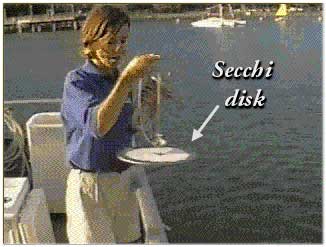|
|
MATERIALS
- a pre-constructed secchi disk (click here to
see an example of one in use)
- OR you can construct a classroom secchi disk from wood or plastic.
It should be painted white and have weights attached (so it will not
float)
- a rope with graduated depth markings (or knots)
|
|
| |
PROCEDURE
|
|
| |
|
|
Activity
- If possible, take the students out in a boat or along a pier
to test the disk. A pool can also be used.
- Lower the secchi disk into the water. Note the depth -- in other
words, count the marks or knots on the rope -- when the disk is
no longer visible.
|
|
| |
Assessment Ideas
- Students can test different areas of an inland lake or pond,
noting differences in clarity. The water body can then be mapped
and data entered into a journal or portfolio.
- Have students design and carry out an experiment that shows
what different factors influence water clarity.
|
|
|
|
| |
CROSS-CURRICULAR IDEAS
- History/ Social Studies: Where does the term sweet water come
from? How did the settlers of the American frontier choose drinking
water?
- Media Arts: Take a trip to the local water purification plant
and record your trip on a video camera. Construct a presentation on
modern purification techniques
|
|
| |
VOCABULARY
- particulate matter: it is composed of separate individual particles.
In reference to water, the amount of separate individual particles suspended
in the water.
- secchi disk: A device used to determine water clarity
- water clarity: A term used to describe the distance one can
see through water. Clarity is dependent on suspended particulate matter
in the water.
|
|
| |
SOURCE
- Adapted from "Winds of Change" educational CD-ROM, Copyright
Caltech and NASA/Jet Propulsion Laboratory
|
|
